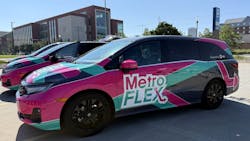Microtransit updates from Metro Transit Omaha, GRTC, CATA
Metro Transit Omaha, the Greater Richmond Transit Company (GRTC) and the Capital Area Transportation Authority (CATA) have added to their microtransit services.
Metro Transit Omaha launches Metro Flex on-demand pilot service
On Aug. 13, Metro Transit Omaha launched Metro Flex, an on-demand, app-based public transit pilot service in partnership with Via Transportation. Metro Transit Omaha notes Metro Flex is a link to all of its transit services, including buses, Omaha Rapid Bus Transit (ORBT) and MOBY, Metro Transit Omaha paratransit service.
According to the agency, Metro Flex will allow anyone within one of three designated service zones to book an on-demand ride through the Metro Flex OMA app or by phone.
“Every day, we make a promise to our community,” said Metro Transit Omaha CEO Lauren Cencic. “Metro Flex builds on that promise and furthers our commitment to connecting people to opportunity by meeting riders where they are.”
The agency notes that once a rider has booked a trip, Via’s algorithms match riders headed in the same direction in one shared vehicle to create quick, efficient trips, creating a flexible option that extends Metro Transit Omaha's bus service, allowing people to get farther and quicker. Metro Transit Omaha says the service provides a great first and last mile option for neighborhoods where big bus service may not function well.
“Via is proud to partner with [Metro Transit Omaha] and integrate our flexible tech and operations with Omaha’s transit network,” said Via Senior Vice President of Strategy and Planning Dan Berkovits. “With Metro Flex, residents can conveniently reach the entire transit network, and in turn, connect more easily with the exciting and important opportunities that Omaha has to offer.”
Omaha Mayor John Ewing, Jr., added, “There’s a lot to love about Metro Flex, starting with real-time, on-demand service. This is an innovative and important response to getting around Omaha. Transportation should not be a barrier to our residents, and I’m grateful to Metro Transit for seeing a need and responding.”
Metro Flex will operate in three zones: the North Zone, South Zone and West Zone. Metro Transit Omaha notes each zone has access to between seven and 11 of its bus routes. Each zone also has at least one transit center, providing access to key connections across Omaha.
“Metro Flex takes the best of the tech world and melds it with the promises public transit provides to deliver a flexible service that will help Omaha and the overall metro region grow into the future,” said Regional Metropolitan Transit Authority of Omaha Board Chair Curt Simon. “It fills important gaps, making it easier for people to reach jobs, school, healthcare and more.”
According to the agency, riders will be able to request on-demand rides when they’re within one of the three zones and go anywhere within the zone they requested the ride in. If they want to get to another zone, they can connect to a bus route to finish the trip. Metro Transit Omaha says the North Zone also includes three additional destinations to better connect riders: 33rd & Dodge ORBT station, Open Door Mission Campus and Eppley Airfield.
“The Chamber joins Metro Transit in celebrating the launch of their new microtransit pilot service, a first for Omaha,” said Heath Mello, Greater Omaha Chamber president and CEO. “This service will be transformational for many, providing greater mobility and enhancing transportation options for Omaha residents. In Omaha, we are working every day to create a more connected and accessible community and public-private partnership efforts like this take us even closer to our ultimate goal.”
According to the agency, the Metro Flex pilot launched with a two-month free introductory period. Starting on Oct. 15, rides will cost $3. Metro Transit Omaha says the fare includes the cost to transfer to a fixed bus. Metro Transit Omaha's pass programs, including half-fare and K-12 Rides Free, will not apply. Metro Flex will be available Monday through Friday from 6:00 a.m. to 9:00 p.m., Saturday from 7:00 a.m. to 8:00 p.m. and Sunday from 8:00 a.m. to 6:00 p.m. The fleet includes wheelchair accessible vehicles and vehicles with bike racks.
Metro Transit Omaha notes Metro Flex is a two-year pilot project with a possibility of running up to five years. It was made possible through several generous philanthropic organizations.
GRTC growing LINK microtransit service
GRTC says its LINK microtransit service is seeing ridership grow following its summer expansions, with even more service set to roll out next month.
According to the agency, LINK service in Powhatan, Va., grew to cover the entire county, creating GRTC’s largest zone at 252 square miles. Since the expansion, the agency notes daily ridership has shown strong momentum, as riders can now travel anywhere in the county and reach destinations outside its borders, including Chesterfield Towne Center and Westchester Commons, where riders can connect to Bon Secours Westchester Medical Park, Johnston-Willis Hospital and GRTC’s full network via Route 1A.
GRTC notes the Sandston LINK zone also expanded to add 6.5 square miles, bringing service to high-demand areas, including Rocketts Landing, White Oak Village and several nearby schools. The expansion prepares for the retirement of Route 56 in September 2025.
GRTC says its move to retire Route 56 is not just a service change, but also a step toward a cleaner fleet. The route currently operates with diesel buses due to a low bridge along the corridor that cannot accommodate taller compressed natural gas buses. Once Route 56 is replaced by LINK, GRTC will no longer operate diesel buses on any regular fixed route. LINK will maintain the same connections to routes 4A, 4B, 7A, 7B, 91 and the Pulse.
The agency notes the growth of LINK will continue this fall. In September, a new Broad Rock zone will launch, bringing the total to six LINK zones and expanding flexible, on-demand transit to even more residents. Riders can book trips using the GRTC on the Go app or by phone. GRTC says LINK currently operates at zero fare.
CATA expands CATA Rydz pilot program
CATA has expanded its CATA Rydz microtransit pilot program, which has been operating as a pilot program since last fall. CATA notes the app-based service provides alternatives to reaching destinations and connecting to the region’s public transit systems across three zoned areas.
Grant funds secured in 2024 have allowed CATA Rydz to address a gap in late-night transit service, particularly among Lansing, Mich.’s, marginalized transit-dependent population. CATA has launched Rydz Late-Night, connecting Lansing residents to the Delta Township zone, providing needed access to third-shift job opportunities and late-evening venues across the two zones.
According to CATA, late-night riders are required to schedule trips at least two hours in advance via the CATA Rydz app. The service is available 8:00 p.m. to 11:30 p.m. seven days a week. Early morning trips can also be arranged every Saturday and Sunday from 5:30 a.m. to 9:00 a.m. Travel must take place between the Lansing late-night and Delta Township zones. Rides within a zone are not available during late-night hours. CATA notes the fare is the same across all CATA Rydz zones; $1.25 per one-way trip.
Refinements to the original CATA Rydz zones have also been implemented:
- Delta Township’s zone has expanded to increase on-demand travel and broaden access to regional transit services. The boundaries now extend north to Willow Highway and east to portions of Creyts and Waverly roads.
- Downtown Lansing’s zone has also expanded, providing more solutions for on-demand travel and access to CATA’s fixed-route system. The new zone extends north to Old Town, east to Pennsylvania Avenue, south to Mount Hope Avenue and southwest to a portion of Waverly Road.
- The Airport/MSU service has extended service until 1:00 a.m., as all ride requests move to a prebooking reservation. Travelers must schedule their rides at least two hours in advance.
CATA notes riders can also plan trips and view routes for CATA Rydz directly in Transit app.
About the Author
Brandon Lewis
Associate Editor
Brandon Lewis is a recent graduate of Kent State University with a bachelor’s degree in journalism. Lewis is a former freelance editorial assistant at Vehicle Service Pros in Endeavor Business Media’s Vehicle Repair Group. Lewis brings his knowledge of web managing, copyediting and SEO practices to Mass Transit Magazine as an associate editor. He is also a co-host of the Infrastructure Technology Podcast.

